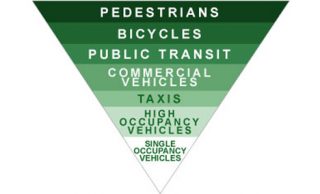
maybe the city’s single most progressive statement of
transportation policy.
The City of Portland says (PDF) its new 20-year comprehensive plan is informed by three city documents that created a prioritized ranking for transportation needs.
But it’s an open question whether the “green transportation hierarchy,” as it’s been known since its creation in 2009, will be fully enshrined in the 20-year comprehensive plan as it previously was in the Sam Adams-era Climate Action Plan, Bicycle Plan for 2030 and Portland Plan.
Members of the city’s Bicycle Advisory Committee are making it one of their top requests to the city to keep the chart in place and intact.
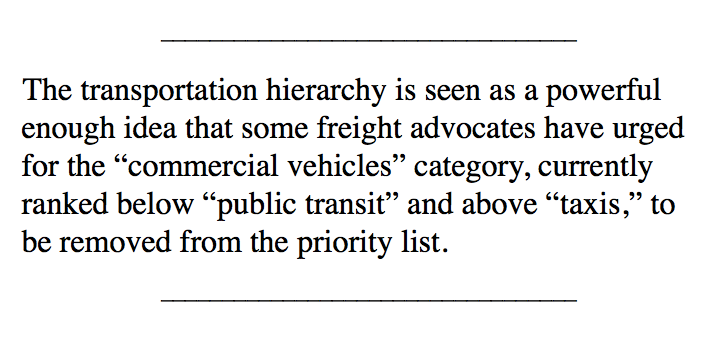
The chart is, of course, just a chart. As recently as last summer, the city was proposing to spend $30,000 to narrow a sidewalk in a commercial area in order to preserve three on-street car parking spaces next to an unused offstreet private parking lot.
But the transportation hierarchy is seen as a powerful enough idea that some freight advocates have urged for the “commercial vehicles” category, currently ranked below “public transit” and above “taxis,” to be removed from the priority list.
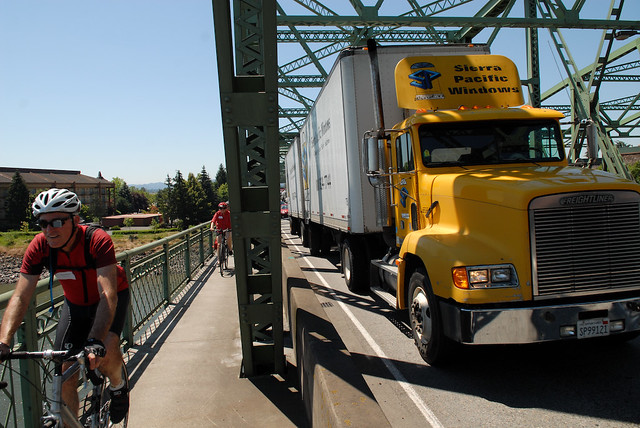
(Photo: J.Maus/BikePortland)
“Commercial vehicles kind of don’t really fit into a green hierarchy. or if you did put them into a green hierarchy they’d probably fit at the top of the pile,” said Corky Collier, executive director of the Columbia Corridor Association of freight customers. “They’re moving a lot of goods and services very efficiently.”
In the end, Collier said there’s no hierarchy that can usefully weigh moving a 150-pound person against moving 150 pounds of commercial goods.
But biking advocates like Ian Stude, chair of the city’s Bicycle Advisory Committee, and Rob Sadowsky, executive director of the Bicycle Transportation Alliance, argue that the interests of commercial vehicles often need to be weighed against other priorities.
Advertisement
“The green hierarchy is not just about environmental green,” Sadowsky said Tuesday. “It is about keeping traffic moving, about successful business districts and about safety.”
The conversation comes as the city’s Planning and Sustainability Commission is asking for public input on the city’s 20-year comprehensive plan, which this year is due for its first update since the 1980s. As part of its outreach process, the city is asking residents and other stakeholders to sift through 83 pages of online transportation project lists to select their five most important projects.
For example, there’s project 40109, a neighborhood greenway on NE 14th Avenue between Halsey and Lombard, expected to cost $774,000 and be built sometime in the late 2020s or early 2030s, or project 50015, “Gateway 99th/96th streetscape improvements,” which would “reconstruct primary local main street in Gateway Regional Center.” That’s expected to cost $4.9 million and happen in the next 10 years.
Like the city’s Bicycle Plan for 2030 (which was one of many documents the city used to help build this list), there’s no money attached to these plans. The purpose of this ranking is to help the city decide which projects to try to find money for.
If you’d like to participate in the city’s “top five” exercise, you can find your favorites in the project lists on this page and emailing them (with your name and home address) to PSC@portlandoregon.gov and TSP@portlandoregon.gov. Alternatively, you can submit comments through the city’s map app, or testify in person at a hearing this evening or by mail. Here are the city’s instructions (PDF) on how to do those things.
That’d also be a way to share feelings on the city’s transportation hierarchy.


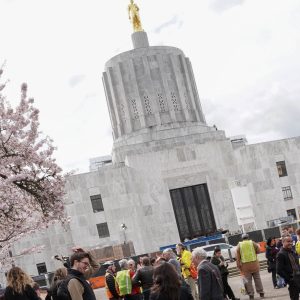
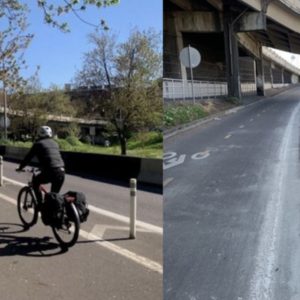
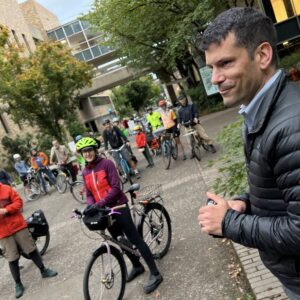
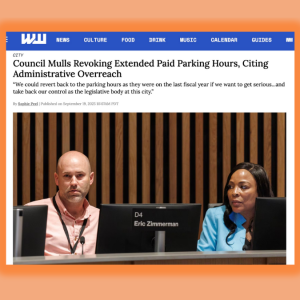
Thanks for reading.
BikePortland has served this community with independent community journalism since 2005. We rely on subscriptions from readers like you to survive. Your financial support is vital in keeping this valuable resource alive and well.
Please subscribe today to strengthen and expand our work.
A compromise would be to transfer the goods at a facility outside the city from large 55′ trucks to smaller ones which can better navigate urban streets and have smaller blind spots.
And are electric.
A quick I’m-just-curious googling of “freight in European cities” landed me at FIDEUS, Freight Innovative Delivery in European Urban Spaces:
http://ec.europa.eu/research/transport/projects/items/fideus_en.htm
“The aim of the project is to provide a complementary set of vehicle solutions to support an innovative approach to the organisation of urban freight transport, in line with political strategies to safeguard the liveability of cities, while being compatible with efficient logistics. Urban freight delivery is both a contributor to and a victim of the growing congestion in urban areas, which exposes the population to noise, pollution and nuisance. The target of FIDEUS is to contribute to the economic livelihood of business and retail activities located in the city in a practical way, with policies oriented towards more sustainable mobility.” (Emphasis mine.)
They propose a whole system of delivery mechanisms for moving goods off big trucks and trains and into the heart of cities, right down to pedestrian-only areas. Not just the vehicles, but container systems and handling operations. It’s pretty impressive. Seems like Portland, of all American cities, could manage to cherry-pick a few ideas from them.
Here’s a couple from the search ‘driverless freight delivery’:
http://www.ttnews.com/articles/basetemplate.aspx?storyid=33907
http://www.freightshuttle.com/concept/
Keep in mind that the topic is green hierarchy. Using smaller vehicles will increase greenhouse gas emissions (and congestion) because fewer vehicles are on the road. Delivering in a Prius vs. a 30 year old UPS van would use 9.5 times more fuel and 50 more trips. This is assuming a full load; if the truck is not full, using a smaller vehicle makes a lot of sense.
Using a central distribution center near downtown to transfer to smaller electric trucks is a recommendation in the Portland Sustainable Freight Strategy we wrote two years ago. It would require reversing the pressure many central eastside freight businesses feel to move. Other suggestions include night time deliveries, which freight haulers love, but retail shops shy away from. There’s no silver bullet, but a lot of interesting ideas.
How many lives are worth the GHG efficiencies gained by using articulating 50ft trailers in an urban environment? In my opinion, safety should be the priority. Using 30ft non-articulating trucks with side-underride protection will save lives.
“They’re moving a lot of goods and services very efficiently.”
There’s that dreaded word efficiency again. It is used to perpetuate so much mischief; as a club to beat whoever one’s opponent is. What are the units? And are you comparing the current fleet of trucks with anything that isn’t powered by diesel or fossil-fuel-generated electricity? As Anne’s helpful link points out, there are other places, other interests that fortunately take a more interesting approach to this problem.
“In the end, Collier said there’s no hierarchy that can usefully weigh moving a 150-pound person against moving 150 pounds of commercial goods.”
I haul pretty much everything by bicycle/trailer. Your past statements here on bikeportland suggest that you are of the opinion that ‘real’ freight can’t be hauled by bicycle, or for that matter with anything other than a fossil fuel. But in a disaster, in a climate-constrained future, after the cheap oil is all burned, your fossil fuel machines aren’t going to be hauling much of anything anywhere. Why not start to plan for those circumstances? Concede or at least allow that just because the 20th Century was marked by a steady shift toward bigger, more powerful trucks, doesn’t mean the 21st Century will necessarily look anything like that.
And let’s not forget why we even need a hierarchy. Because the cars and trucks suck all the air for the rest of us out of the room, introduce the element of scarcity into our transportation landscape. Once those machines have dried up and blown away, we can all mix it up again with no need for hierarchies.
Freight distribution seems like a good candidate for driverless vehicles. Small loads, distributed/gathered widely from/to a central freight managment center. Containers off-loaded into dedicated spaces in the parking lane, freight zones, instead of truck loading zones. Airlines already containerize luggage going a particular direction/flight path.
It’s nice that they want opinions, but to do the email option will require a TON of reading and investigating. The Map APP is nice but how will they weight these opinions vs. email vs. showing up in person? I’m guessing in reverse order as I list them.
I’m wondering why the Transportation Hierarchy reproduced above puts walking above cycling? I like to walk and I walk a fair amount, but it can’t compare with a bicycle if we’re talking about actual transportation. Commuting, for example, is for me 15 minutes via bike vs. an hour walking. And carrying something, like a laptop or my lunch, is much easier. I don’t think walking can claim any environmental benefits over cycling either. So why is it at the top? I didn’t see an explanation for it in the Climate Action Plan just now.
Walking is the original form of transport and the only one inherent to being human.
Walking to the bus is also cheaper than riding a bike to the bus.
“Walking to the bus is also cheaper than riding a bike to the bus.”
Come again?
I fuel my biking self with the same calories I fuel my walking self. By some measures the former uses fewer calories/mile.
And you had to buy and maintain a bike. People that walk, don’t have that expense.
“And you had to buy and maintain a bike. People that walk, don’t have that expense.”
This is tiresome. You know, some of us don’t buy expensive bikes, get our tires out of the dumpster when the sidewalls wear thin, and ride our bikes forever. The incremental wear/cost is basically nil. I’m sure plenty of people spend more on their shoes, if we’re really counting everything, but I don’t really see the point.
People in wheelchairs and using crutches need solid pedestrian infrastructure, not bike lanes first.
Okay wait a minute. I didn’t say walking shouldn’t be on the list, but I think that if we’re talking about effective transportation for moving the greatest number of people with the lowest environmental impact, biking offers more potential than walking. Sure, we’ve been walking for millions of years; how many people on BikePortland would switch to walking if for some reason biking was no longer possible for them? Walking to the bus means you’re taking the bus; while I do this occasionally myself and it’s much better than driving it’s not as low of environmental impact as biking. Biking offers the lowest environmental impact for the greatest number of people (potentially, at least).
I’m afraid this feels like public involvement for peanuts.
What’s the use of adopting a green hierarchy as policy without shifting the general conversation regarding transportation funding at meeting users’ needs in that order? It looks like a policy whitewash: “we wish we could do it this way, however because we’re used to fixing potholes we’ll fix potholes”.
After all, we can’t even advocate for bicycle and pedestrian project by their name, we’ve had to rename them “safety projects”.
PBOT engineers I’ve talked to say this would change their whole outlook at the design phase, if it was the basis for their job. Engineers design to specs, and this is the big one.
Keep in mind even the 20-year comp plan doesn’t legally bind the city to actually follow any of its guidelines, at all. Its kind of just a guidance document that, because of the input and involvement by BPS, PBOT and other bureaus means that many of its facets will be followed. But there isn’t anything in it that actually requires the city to implement it.
“The transportation hierarchy is seen as a powerful enough idea that some freight advocates have urged for the “commercial vehicles” category, currently ranked below “public transit” and above “taxis”, to be removed from the priority list.” Yep, that is a real good idea, go from the middle of the list to nowhere on the list. That will ensure you get lots of funding /snark
Laura O Foster has something to say about SW Portland:
http://swtrails.org/2015/02/24/transportation-system-plantsp-letter-from-laura-foster/
I’d love to see someone put forward a solid, feasible plan for after-hours use of the MAX and Streetcar lines for moving freight; from airport and suburban distribution facility to central city staging area to light neighborhood delivery vehicle, whether that be van or cargo bike.